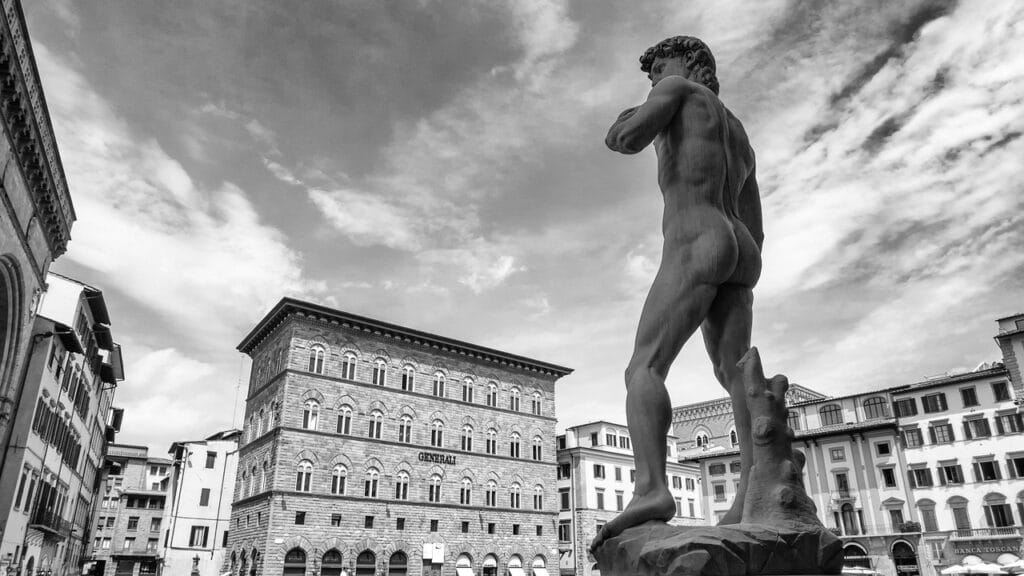

Introduction
Marble Wars
Florence is not just a museum city — it’s a battleground of marble, a stage where sculptures speak of rivalry, ambition and revenge. The rivalry between Michelangelo Buonarroti and Baccio Bandinelli was far from gentle chisels and quiet studios: it was a cold war of muscles, monuments and malice. Bandinelli, an ambitious and temperamentally wounded sculptor, nurtured an envy of Michelangelo so colossal he aimed to surpass him… by sculpting monuments. Meanwhile Michelangelo carved gods that seemed ready to breathe. Bandinelli carved… volumes. Many volumes.
Rivalry between Michelangelo and Bandinelli – Rivalry between Michelangelo and Bandinelli
First and foremost, the marble rivalry between Michelangelo and Bandinelli boiled down to a clash of philosophies. According to Giorgio Vasari, Bandinelli lacked the “terribilità” of Michelangelo: that force of expression, the perfect anatomy, the dramatic pathos. (Wikipedia)
Yet he made up in marble volume. He thought: “Michelangelo made David? I’ll place in front of him an Ercole e Caco!” But the result was more “Ercole and cacophony”. The sculpture group, placed in the Piazza della Signoria as a direct challenge, was greeted by Florentines with market-stall sarcasm. A local pasquinade read:
“Ercole non mi dar, che i tuoi vitelli
Ti renderò con tutto il tuo bestiame,
Ma il bue l’ha avuto Baccio Bandinelli.” (Cultura Commestibile)
Translated loosely: the crowd wasn’t fooled by the muscular marble, and the ox symbol of clumsiness was lodged at Bandinelli’s feet. a Marble Wars in few wards…
The Monumental Challenge – The Monumental Challenge
In addition to Michelangelo, Bandinelli found a nemesis in Benvenuto Cellini, the goldsmith-sculptor with an explosive temperament. The two loathed each other with such intensity they turned the halls of Palazzo Vecchio into a verbal arena. Bandinelli, in a fit of fury before Cosimo I de’ Medici, accused Cellini of “homosexual inclinations” (with the tone more inquisitorial than artistic). Cellini responded in his autobiography with one of art history’s most memorable critiques:
“A sausage-bag of melons leaning against a wall.”
This is how he described Ercole e Caco. (Wikipedia)
Not art criticism: fruit-vendor review.
The Sculpture of Revenge – The Sculpture of Revenge
And as if the rivalry weren’t theatrical enough, tradition holds that Vincenzo de Rossi, a pupil of Bandinelli, sculpted in the face of the subdued Caco… none other than Michelangelo. A low-blow served in marble. The revenge, in Florence, is never served cold: it is served in marble.
The sculpture in question, Ercole e Caco, is a white marble group by Bandinelli, completed around 1534 and situated in Piazza della Signoria, in front of Palazzo Vecchio. (Wikipedia)
It was originally intended for Michelangelo, but eventually awarded to Bandinelli — a fact that adds to the tension of the piece. (Wikipedia)
Why the Marble War Still Matters – Why the Marble War Still Matters
- It encapsulates the tension of Renaissance Florence: politics, art, patronage, ego.
- It shows how marble wasn’t just material, but medium of message — a symbolic front line.
- Today when you stroll past the statue you can sense the echo of competition, of ambition, of vindication.
Visiting Florence’s Battlefield – Visiting Florence’s Battlefield
If you go to Florence and stand in Piazza della Signoria, you’ll see Michelangelo’s David (or rather, a copy) facing Bandinelli’s exaggerated giant. You’ll feel the challenge. You’ll know the story. And you’ll understand how in Florence, marble doesn’t only stand still — it speaks.
Conclusion
Marble Wars
In Florence the story wasn’t just about sculpture. It was about rivalry carved deeply in stone. Michelangelo vs Bandinelli. Genius vs emulation. Breath vs bulk. And one day, Bandinelli may have looked at Michelangelo’s David and thought: “I’ll carve more marble, I’ll carve louder muscle.” But the Florentine crowds didn’t buy it. They handed the number of the ox to Bandinelli, and chuckled. And thus the marble war remains, for us, a story in stone. Marble Wars
External links
- Wikipedia: Hercules and Cacus – overview of the work by Bandinelli.
- Wikipedia: Baccio Bandinelli – biography and context of the artist.
- Storie Urbane article: Ercole e Caco, la maestosa scultura di Baccio Bandinelli – detailed Italian article with legends.
- Comune di Firenze press release: restoration of Ercole e Caco – restoration and site information.



